Key takeaways:
- Evaluating resources is essential in music education for enhancing learning outcomes and avoiding inaccuracies.
- Key evaluation criteria include credibility, relevance, and engagement level of the resources.
- Practical assessment methods like peer reviews, trial periods, and reflective journaling can significantly improve resource selection.
- Challenges in resource quality include alignment with educational goals, staying current with technology, and ensuring emotional resonance with students.
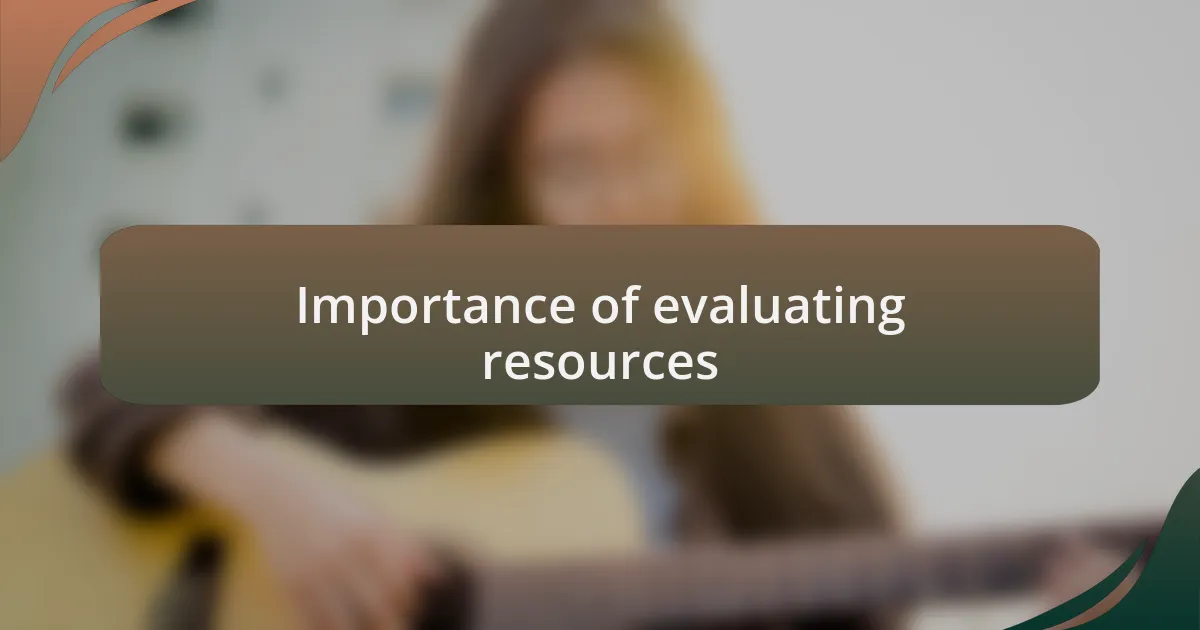
Importance of evaluating resources
Evaluating resources is crucial in music education because the quality of the material directly impacts learning outcomes. I remember a time when I eagerly downloaded a free music theory ebook, only to find it riddled with inaccuracies. That experience made me realize that not all resources are created equal; some can really mislead students.
When I reflect on my early teaching days, I often think about how I sometimes relied on less credible sources. It wasn’t until I noticed my students struggling with concepts that I understood the importance of vetting resources thoroughly. Are we really doing our students a favor by presenting anything less than the best information out there?
In a world overflowing with content, having a discerning eye for evaluating resources is essential. I’ve found that prioritizing high-quality materials not only enhances my teaching but also fosters a more enriching experience for my students. This assessment process reminds me of curating a playlist; each song needs to resonate and support the overall vibe, just like each resource should contribute meaningfully to our educational goals.
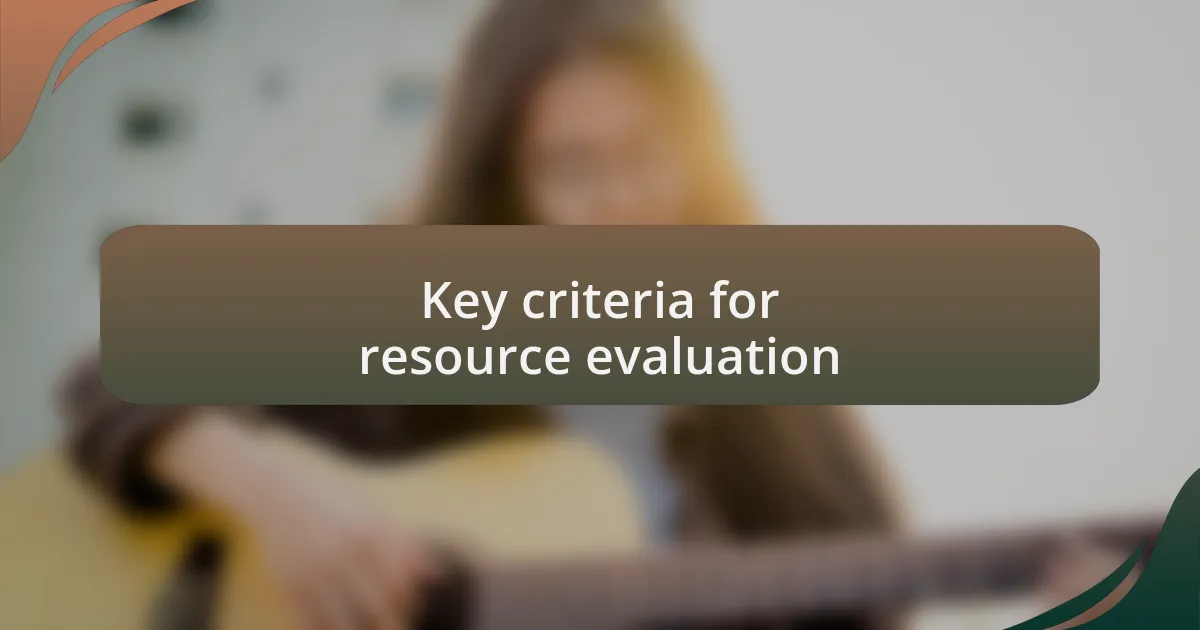
Key criteria for resource evaluation
When I evaluate resources for music education, I focus on a few key criteria. First, I always consider the credibility of the source. For instance, I once stumbled upon an online article authored by an unknown individual claiming to unravel the secrets of music composition. As I read through it, I not only questioned the validity of the information but also felt uneasy about sharing it with my students. If I can’t trust the author, then I can’t trust the material, right?
Next, I pay attention to the relevance of the content. I recall a time when I found a fantastic resource on jazz improvisation that seemed promising. However, upon closer inspection, I realized it was outdated and not aligned with modern teaching practices. This experience taught me that a great resource must not only be accurate but also timely and applicable to current learning contexts. When I think about the lessons I want to share, I ask myself: Does this material truly aid in bridging the gap between students and the concepts they need to grasp?
Lastly, I assess the engagement level of the resource. I remember introducing a new interactive music app to my class, which transformed our understanding of rhythm exercises. The app wasn’t just informative; it actively involved students in the learning process. I often find myself pondering: Are the resources I’m choosing inspiring curiosity and a desire to explore further? When materials ignite passion and interest, they create a dynamic and exciting learning atmosphere, which is precisely what I aim to achieve in my classroom.
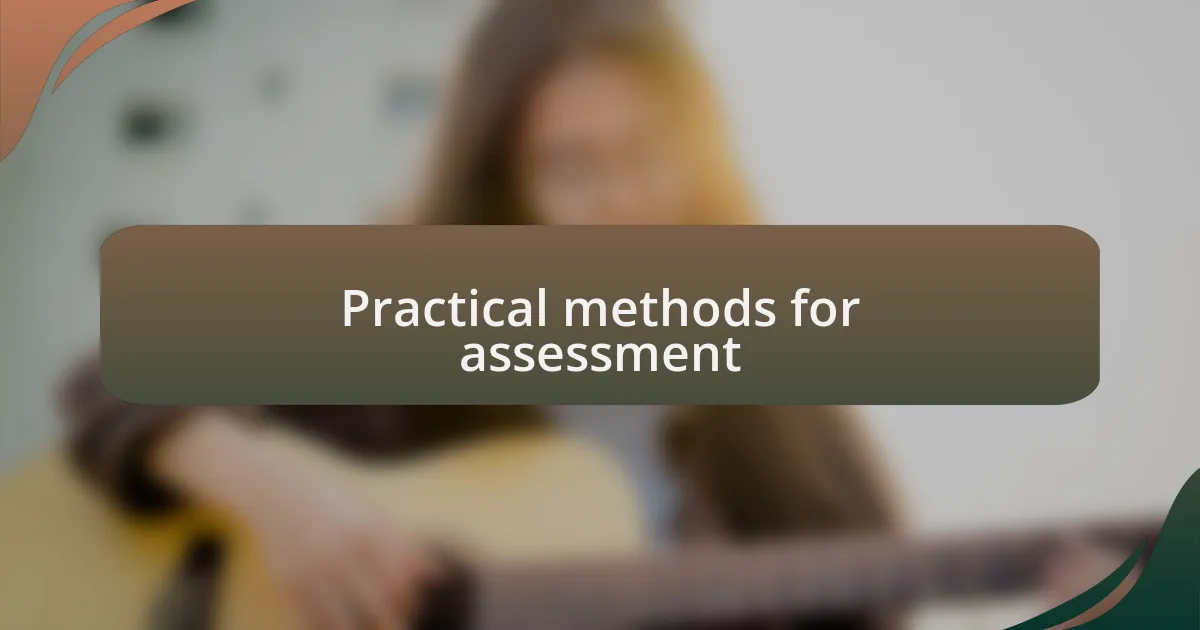
Practical methods for assessment
Practical methods for assessment involve hands-on techniques that allow me to thoroughly gauge the quality of a resource. One method I often use is peer reviews. I remember once collaborating with fellow educators to evaluate a new curriculum guide. As we exchanged feedback, I realized how diverse perspectives amplified our understanding and pointed out strengths and weaknesses that I might have overlooked on my own. This collaborative effort not only honed my assessment skills but also deepened my appreciation for the resource.
Another effective method I incorporate is a trial period for new materials. When I introduced a fresh online platform, I dedicated a week to experimenting with it alongside my students. Observing their reactions and engagement levels gave me invaluable insight into the resource’s effectiveness. Did they struggle to grasp concepts, or were they genuinely excited? It’s fascinating how real user experience can reveal nuances that static reviews simply can’t capture.
Lastly, I find that reflective journaling about each new resource I assess has enhanced my understanding immensely. After using a particular tool in class, I take the time to jot down what worked, what didn’t, and how students responded emotionally. Did they light up with excitement? Or were they disengaged? By doing this, I not only track the resource’s impact over time but also create a concrete record that informs my future choices. How can we possibly improve our teaching practice without such reflective insight?
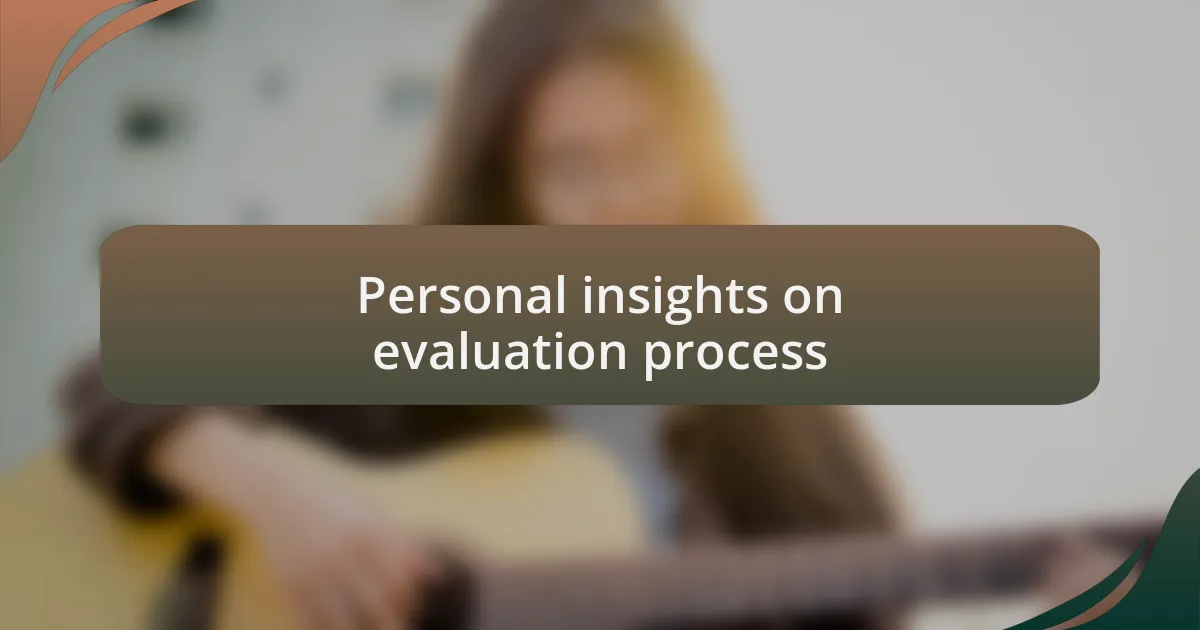
Personal insights on evaluation process
When evaluating resource quality, I always tune into my intuition, a guiding force that often reveals hidden flaws or strengths in materials. I recall one instance with a resource that appeared stellar on paper, yet during implementation, I sensed a disconnect between the content and my students’ needs. Trusting my gut led me to adjust my approach, making the material resonate more with them. Isn’t it intriguing how our instincts can sometimes speak louder than data?
Engaging with student feedback is another crucial part of my evaluation process. I vividly remember a time when I introduced a music theory app—initially, I was thrilled about it. However, after chatting with my students, I discovered many found it confusing and overwhelming. Their candid insights shifted my perspective, prompting me to seek alternatives. How can we hope to truly refine our resources without listening to the voices that matter most?
Moreover, I find that emotional responses during lessons provide a lens to assess resource effectiveness. I often ask myself: are my students emotionally invested in what we’re learning? In one class, I tried a new percussion teaching method, and the energy was palpable. Students were visibly excited, clamoring to try different instruments. That moment taught me more about the resource’s quality than any review could; it’s the enthusiasm and connection that ultimately enriches the learning experience.
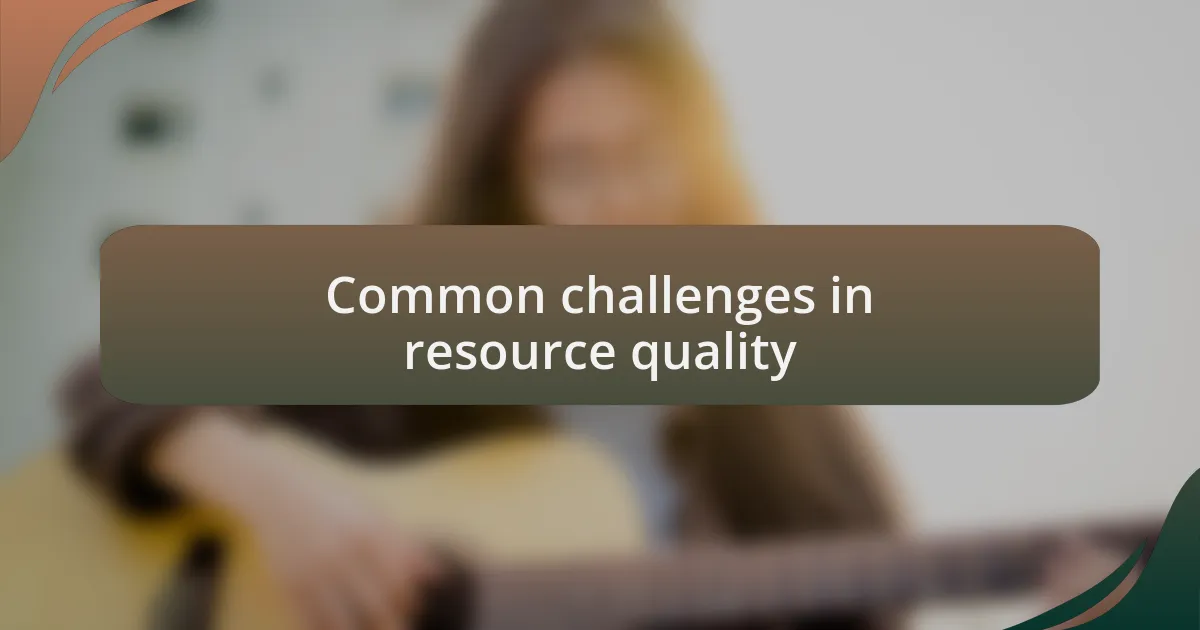
Common challenges in resource quality
Evaluating resource quality often brings certain challenges to the forefront, particularly when it comes to alignment with educational goals. I remember reviewing a curriculum guide that seemed comprehensive yet fell short in addressing the specific needs of my diverse student group. It was a tough realization—how can something that looks impeccable on paper truly miss the mark in practice?
Another significant challenge is staying current with rapidly changing technology and educational trends. There was a time when I invested in a cutting-edge software for music composition, only to find that my students preferred using simpler tools for a more intuitive experience. This leaves me wondering: how do we balance the allure of advanced resources with the fundamental requirement for accessibility and usability?
Lastly, the emotional weight of our resources can’t be overlooked. I encountered a resource that was academically sound, but it lacked the passion and creativity that resonate with students. One day, I brought in a piece that inspired me, and I watched my students light up with excitement—it was undeniable. How do we assess the quality of resources that don’t spark joy or motivation in our classrooms? These experiences remind me that quality extends far beyond mere facts and figures; it’s about creating a connection that engages and inspires learners.
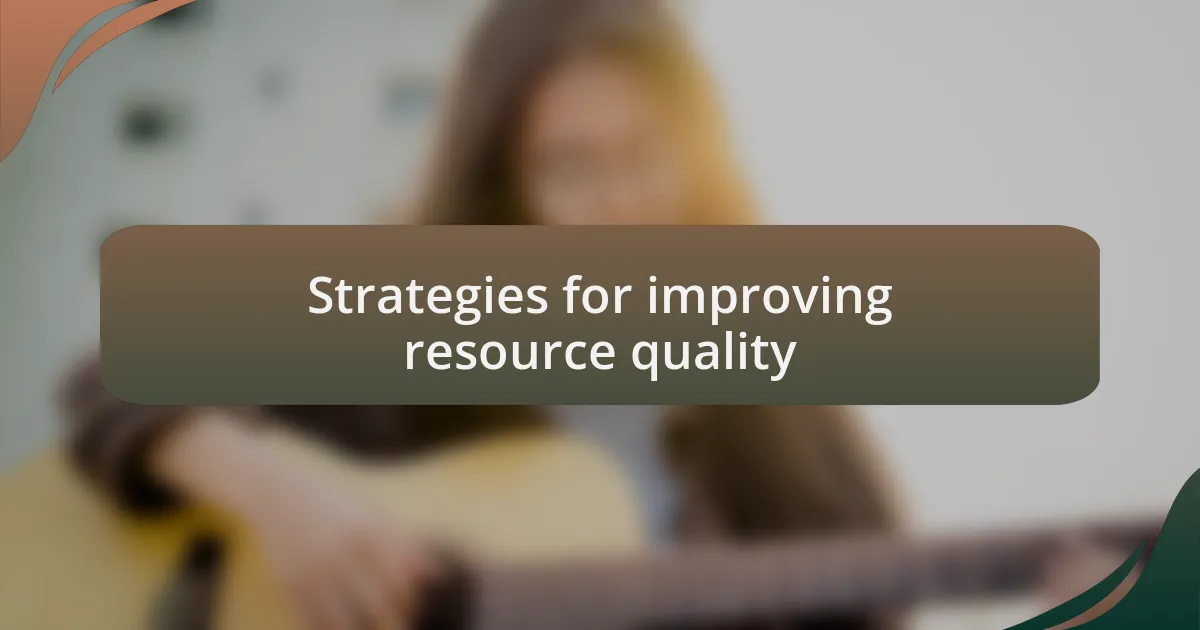
Strategies for improving resource quality
One effective strategy for improving resource quality is to actively seek feedback from both students and fellow educators. In my experience, I once introduced a new music theory workbook to my class, expecting them to love it. However, after a few sessions, I gathered their opinions and realized that the layout was confusing to them. The changes I made based on their feedback not only improved the workbook’s usability but also fostered a sense of ownership in the learning process. Have you ever considered how just asking for input can dramatically enhance the resources you provide?
Another approach involves regularly updating your resources to align with the latest educational research and technological advancements. I learned this firsthand when I transitioned from traditional sheet music to digital formats. Initially, I was hesitant, but as I began incorporating apps that allowed students to annotate and record their insights, I noticed a remarkable increase in their engagement. It made me wonder: what old practices can we let go of to embrace more effective tools that resonate with our current learners?
Lastly, creating a collaborative environment for resource sharing can elevate quality significantly. I recall a time when our department hosted an informal sharing session, where we exchanged favorite teaching materials and approaches. One resource, a compelling video about famous composers, sparked a lively discussion among my peers about integrating multimedia in lessons. That session not only enhanced my own resource pool but also built a supportive network of educators eager to improve each other’s practices. I find it inspiring how much we can elevate our resources through collective effort—what if we began to think of ourselves as co-creators in this journey of education?